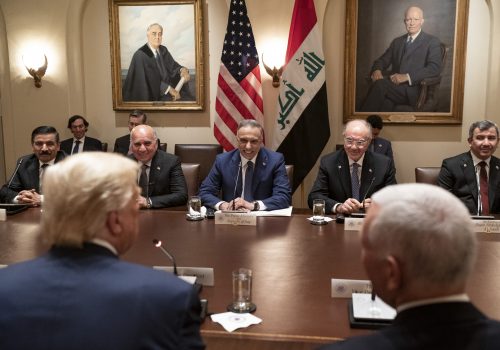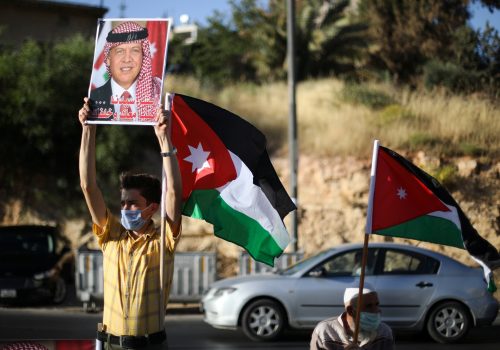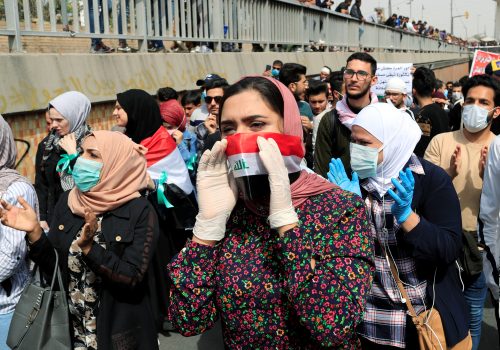How attacks on US forces in Iraq became a new normal
Rocket attacks on Iraqi bases housing US forces and improvised explosive device attacks (IED) on logistical convoys bringing supplies to US forces have become a new kind of normal in Iraq. However, the dozens of attacks over the past year and a half have been waged with certain unwritten rules that result in few casualties since US-Iran tensions began to increase in May 2019. While the United States’ use of “contested deterrence” has successfully responded to these attacks in ways that prevent dangerous escalation, the new campaign has also pushed the United States toward withdrawal—a goal of pro-Iranian militias in Iraq.
The recent Trump administration practice of responding with force only in cases where there are Coalition casualties appears to have deterred larger attacks and resulted in trickle attacks that represent continued harassment and pressure on the United States to leave Iraq. Evidence in the last six months point to the effectiveness of this deterrence strategy.
In general, US-led Coalition and the local Iraqi Security Media Cell are transparent and consistent in reporting attacks on various bases across Iraq where US forces are present. The types of attacks generally come in two forms: rocket attacks on bases and IED or sabotage attacks on convoys. The more recent targeting of supply convoys have been done with 107mm rockets. These types of rockets have a long history of being used by groups linked to Iran, including in Syria and in shipments to Hezbollah in Lebanon.
The most recent trend in Iraq has been in explosive devices targeting supply convoys that are linked to the US presence in Iraq. US-led Coalition spokesperson in Iraq, Myles Caggins, rejected reports of an attack on an Iraqi contract convoy at the Iraq-Kuwait border on August 11, but there have been several others, including on August 21.
While the rocket attacks began to increase in May and June 2019, coinciding with US-Iran tensions in the region, they surged in the fall of 2019 to the point that US officials began to indicate that they believed Iran was indirectly behind the attacks. These attacks targeted a variety of bases, such as Balad, Taji, Q-West, the US embassy in the Green Zone, and areas used by US forces near the international airport in Baghdad. The attacks also share a similar pattern; they consisted of 107mm rockets that were usually placed on a launcher on the ground or in the back of a truck, which were then triggered by perpetrators who would vanish into the night. No claims of responsibility were taken by any group. However, in December 2019, after a contractor was killed near K-1 base near Kirkuk, the US launched airstrikes against Kata’ib Hezbollah (KH), a paramilitary group backed by Iran. More airstrikes took place in March after three members of the Coalition were killed.
Recently, the United States has abandoned several bases the Coalition had been active at, moving forces from Camp Taji and several other locations in Iraq. The US defended its decision by citing progress in the conflict against the Islamic State of Iraq and al-Sham (ISIS), but the reason seems to have more to do with avoiding attacks on US soldiers at smaller bases and outposts. The US narrative on whether Iran or its proxies have been deterred or whether they are pressuring the US to shift resources has changed over the last months. The end result is that the US is continuing its mission against ISIS with fewer forces from fewer bases and not conducting raids as it has in the past.
When the supply convoy attacks began, new groups emerged to take responsibility. Usbat al-Thairen was announced as a group in March. Another called Ashab al-Kahf claimed an attack on July 15. A third called the Saraya Thawrat Al-Eshreen Al-Thaniya (Second 1920 Revolutionary Company) claimed an attack in May. The attacks have been mentioned in Iranian state media outlet Mehr News Agency, showing the importance Iran may attach to these small harassment activities against US forces and contractors. Not all of the incidents claimed by the two new groups have been confirmed. An August 10 attack, for instance, was denied by the Coalition, despite videos that were posted online and widely circulated on social media. However, these kinds of videos can be recycled from past incidents. Nevertheless, the message is clear: these groups oppose the US presence in Iraq.
In contrast to the new groups that appear on social media and take responsibility, paramilitary groups that have threatened the United States in the past, such as KH, are often part of the Popular Mobilization Units (PMUs) and their leaders are often members of Iraq’s parliament. Hadi al-Amiri, a key leader of the Badr Organization, is also head of the Fatah Alliance in parliament and has opposed the continued US role in Iraq.
Looking back over a year of increasing attacks on US forces, the deterrence effort by Washington has only worked to a certain extent.
Between March 11 and August 18, the volume of these attacks increased, with at least four attacks on convoys and up to twenty-eight attacks reported on bases housing US forces. The number of attacks increased further to almost daily occurrences in mid-August, as Iraqi Prime Minister Mustafa al-Kadhimi flew to the US for meetings in Washington. In that span, there were attacks on two US logistics convoys and a rocket attack on Camp Taji. The US handed over Camp Taji to Iraqi forces on August 23, in a transition that had been planned but coincided with the visit.
Central Command’s General Kenneth McKenzie has called the current US posture in Iraq as one focusing on defeating ISIS, but also one practicing “contested deterrence” with Iran and Iran-backed groups in Iraq that are accused of being behind the rocket attacks. The US has carried out two rounds of airstrikes when rockets inflicted casualties and this appears to indicate that deterrence is designed to carry out retaliatory strikes if there are casualties, but not for rockets that fall harmlessly.
The decision to establish new groups that may claim responsibility for attacks appears designed to distance the incidents from members of the PMU, which are officially part of the government. PM Kadhimi had been at the center of controversy over a June 26 counter-terror raid that briefly detained members of KH. When they were released, they burned his image. This illustrates the difficulty the government has in investigating attacks or seeking to bring perpetrators to justice. No one has been charged with the dozens of attacks that have occurred since May 2019.
US forces are in the midst of a balancing act. They have no mandate to confront Iran and they are in Iraq at the invitation of Baghdad to fight ISIS. This reduction of a US ground footprint appears designed to reduce potential targets of opportunity or friction. Those carrying out the attacks do so as a means to harass US forces and show that they can easily target various strategic bases and sites. However, thus far, their level of attacks has not reached the kind seen in the period of the Iraqi insurgency prior to 2011. This indicates careful planning to not escalate but keep up pressure on US forces amid the strategic dialogue and US-Iran tensions. It is part of a wider campaign by pro-Iranian political parties and groups to pressure the United States to exit Iraq. As such, the US policy of “contested deterrence” has succeeded in sending a message that deadly attacks will be met by force without intensifying the conflict.
Nonetheless, deterrence has still led to pro-Iranian groups largely accomplishing their objective of getting the United States to reduce its presence in Iraq. It appears those carrying out the attacks understand that the Trump administration’s timetable for involvement in Iraq and Syria is determined by the US president’s assertions that the United States no longer needs to be involved in endless wars in faraway places.
Keeping up the pressure on the United States via small attacks that don’t inflict casualties hasn’t risked escalation that would bring additional US troops to Iraq and has enabled the United States to save face by claiming it is conducting a planned withdrawal. Insofar as this is also a form of deterrence where the United States shows that it is ready and willing to conduct airstrikes if necessary, both sides have achieved a kind of modus vivendi through a correct reading of the others’ intensions. Pro-Iranian groups want the US to leave Iraq and the White House seems bent on withdrawal and to let NATO or other countries pick up the slack. The resulting posture of the US in Iraq looks to be a presence concentrated more in the autonomous Kurdistan region—where US forces have never been targeted by rocket attacks—with a very limited presence in Al-Assad base and Baghdad.
Seth J. Frantzman is the executive director of The Middle East Center for Reporting and Analysis and author of After ISIS: America, Iran and the Struggle for the Middle East. He holds a PhD from The Hebrew University of Jerusalem and is a former assistant professor at Al-Quds University. Follow him on Twitter: @sfrantzman.
Image: A U.S. soldier is seen during a handover ceremony of Taji military base from US-led coalition troops to Iraqi security forces, in the base north of Baghdad, Iraq August 23, 2020, VIA REUTERS.


